Not just Boracay...
Budget Jeju: How to Travel to Korea’s Island Paradise Without Spending Your Entire Net Worth
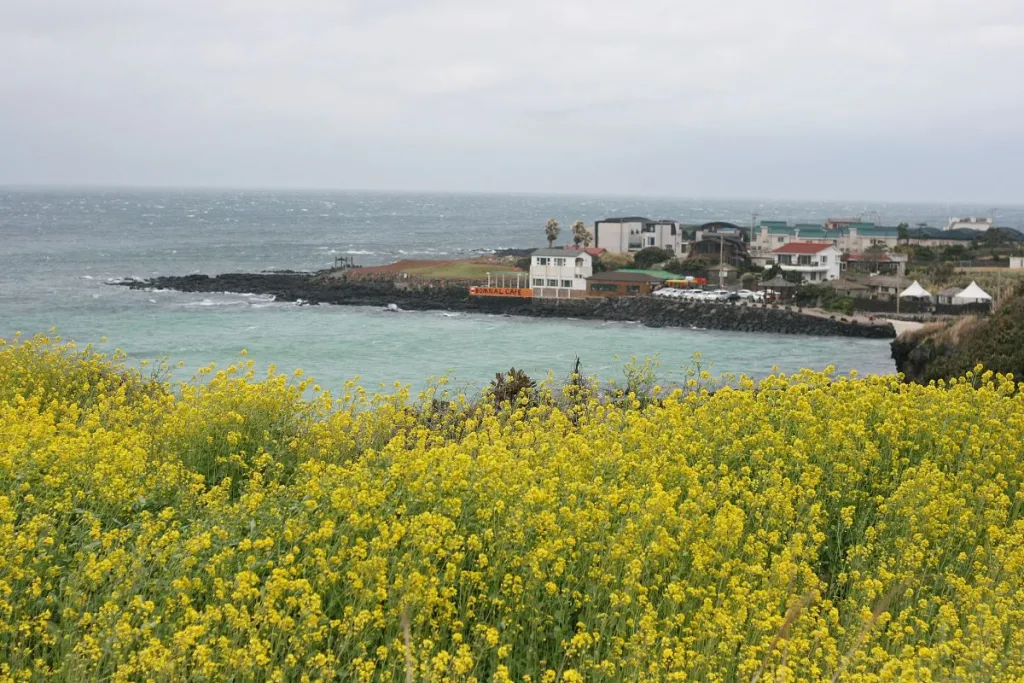
Jeju has always been a bucket-list destination for me, so when the chance to explore Korea’s island paradise came up, I jumped on it! Like many Muslim travellers, I worried about costs, especially pricier Halal options in a non-Muslim-majority country, and assumed daily sustenance and activities would break the bank.
After five days and four nights on Jeju, I discovered that with a little planning, these concerns are totally unfounded. Let HalalZilla crunch the numbers and show you how to turn your dream “Hawaii of South Korea” getaway into an affordable reality!
Also read: Jeju for First-Timers: 15 Top Muslim-Friendly Experiences You Can’t Miss!
1. Flights: Getting to Jeju without breaking the bank
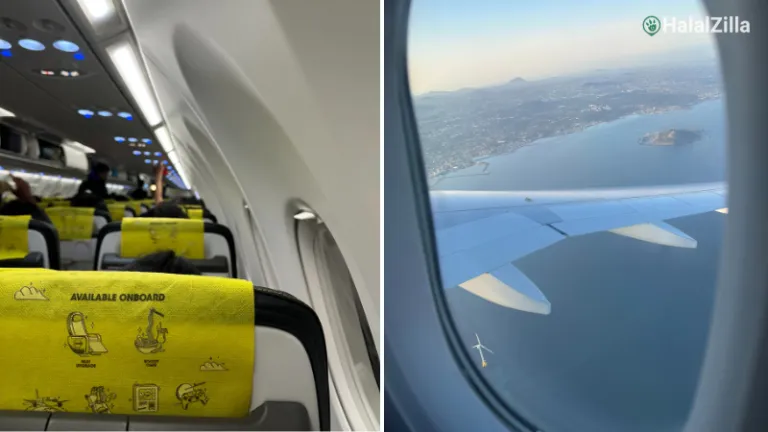 Firstly, we have to start with the big one: How are you getting to Jeju in the first place? For context, I’m from Singapore, so I’m fortunate to have direct flights to Jeju twice a week on Scoot, the budget sister airline to Singapore Airlines. If you’re planning to fly Scoot, fares fluctuate by season, so play with dates on the official site to find the most bang for your buck!
Firstly, we have to start with the big one: How are you getting to Jeju in the first place? For context, I’m from Singapore, so I’m fortunate to have direct flights to Jeju twice a week on Scoot, the budget sister airline to Singapore Airlines. If you’re planning to fly Scoot, fares fluctuate by season, so play with dates on the official site to find the most bang for your buck!
I finally settled on a five‑day trip in the second week of April, which offered the lowest price that month and let me witness Jeju’s iconic cherry‑blossom blooms. So, my return fare from Singapore to Jeju totalled S$814.30. Yowza. That may sound steep, but bear in mind I travelled during peak blossom season, when demand soars.
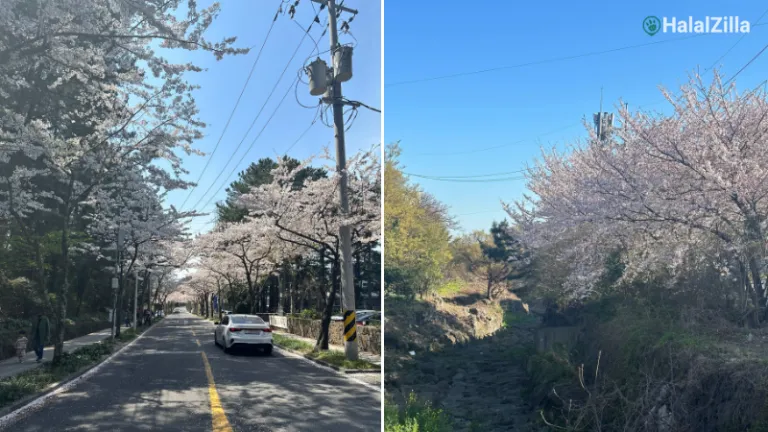 To shave costs, plan your visit for shoulder or off‑peak seasons, so spring (March–May) and autumn (Sep–Nov), but avoid peak foliage periods in April and October, unless you really want to see the seasonal foliage, as I did. If you’re based outside Singapore and lack a direct flight, consider connecting options on aggregators such as Skyscanner and filter prices to suit your budget.
To shave costs, plan your visit for shoulder or off‑peak seasons, so spring (March–May) and autumn (Sep–Nov), but avoid peak foliage periods in April and October, unless you really want to see the seasonal foliage, as I did. If you’re based outside Singapore and lack a direct flight, consider connecting options on aggregators such as Skyscanner and filter prices to suit your budget.
Total damage: S$814.30
2. Where to stay: Affordable comfort in Jeju‑si
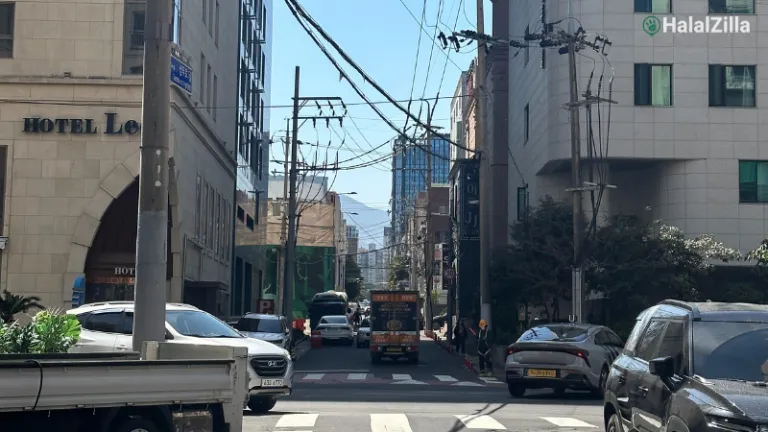 Now comes the next big‑ticket item on your Jeju adventure: Accommodation. Initially, I was intimidated by the thought of dropping a hefty chunk of my pay‑cheque on lodging. However, after plenty of research, I discovered that securing a comfortable base on the island isn’t as pricey as expected. Jeju offers a myriad of options for every traveller: hostels, hotels, apartments and resorts are scattered across the island.
Now comes the next big‑ticket item on your Jeju adventure: Accommodation. Initially, I was intimidated by the thought of dropping a hefty chunk of my pay‑cheque on lodging. However, after plenty of research, I discovered that securing a comfortable base on the island isn’t as pricey as expected. Jeju offers a myriad of options for every traveller: hostels, hotels, apartments and resorts are scattered across the island.
If you want a balance of budget, convenience and comfort, base yourself in Jeju‑si (Jeju City) near the main airport. Also, Jeju‑si is split into two areas. Shin Jeju (New Jeju) bursts with modern hotels, commercial blocks and global brands, while Gu Jeju (Old Jeju) features narrow alleys and plenty of traditional charm.
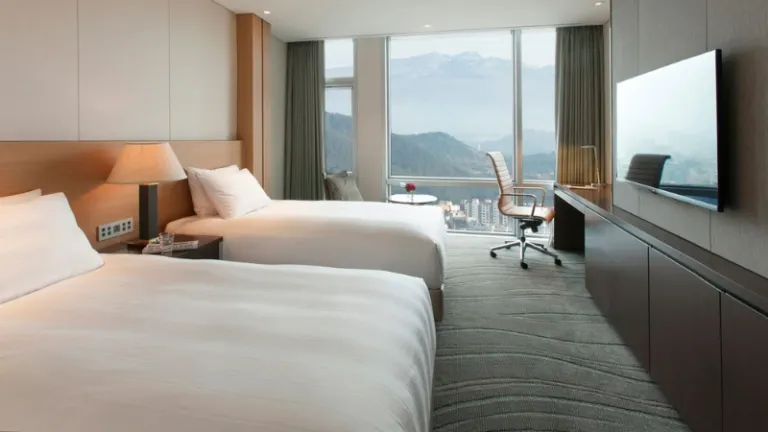 Image credit: Lotte Hotels & Resorts | Official Website
Image credit: Lotte Hotels & Resorts | Official Website
Prioritising privacy and comfort, I chose Lotte City Hotel Jeju in Shin Jeju. My reasoning was threefold: Firstly, it’s only a five‑to‑ten‑minute ride from Jeju International Airport, making transfers quick and painless. Secondly, its central location makes it a key stop for tours and buses: The island’s main (and only) form of public transport. Finally (and why you’re here!), affordability: Rooms at Lotte City Hotel, like many in Shin Jeju, average S$100–S$150 per night for a double!
I booked a twin room and found it extremely comfortable, with daily turndown service plus a pool and gym. Overall, Lotte City Hotel Jeju surpassed my expectations for affordable comfort and convenience. Talk about mixing comfort with affordability!
Total damage: S$462.86 for four nights
3. Getting around Jeju City: Hop‑on, hop‑off ease
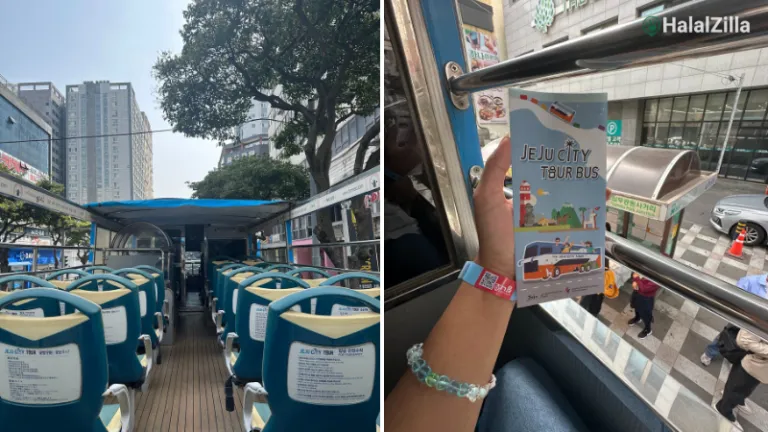 As mentioned, buses are the main (perhaps the only) form of public transport in Jeju‑si – No intricate subway network as in Seoul or Busan! Enter the Jeju City Tour Bus, which loops around Jeju‑si, stopping at 21 key sights. Buy a day pass and hop on and off as often as you like, enjoying seamless travel and a clearly marked, hourly schedule.
As mentioned, buses are the main (perhaps the only) form of public transport in Jeju‑si – No intricate subway network as in Seoul or Busan! Enter the Jeju City Tour Bus, which loops around Jeju‑si, stopping at 21 key sights. Buy a day pass and hop on and off as often as you like, enjoying seamless travel and a clearly marked, hourly schedule.
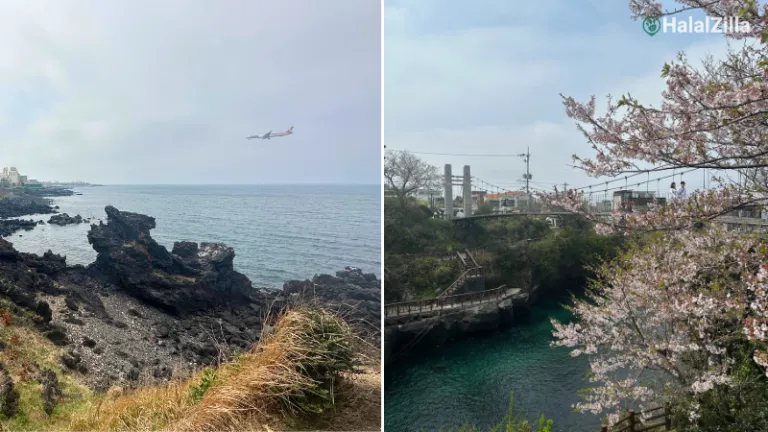 I bought my pass through Trazy, showed the confirmation email to the staff on board, received a wristband “ticket”, and was good to go. Staff speak English, and announcements are bilingual. Thanks to the tour bus, I visited attractions from natural wonders like Yongduam Rock and Dodubong Peak to cultural gems such as Samseonghyeol and the Instagram‑worthy Halla Arboretum and Ihoteu Beach, all for just ₩12,000 (S$11.09) a day!
I bought my pass through Trazy, showed the confirmation email to the staff on board, received a wristband “ticket”, and was good to go. Staff speak English, and announcements are bilingual. Thanks to the tour bus, I visited attractions from natural wonders like Yongduam Rock and Dodubong Peak to cultural gems such as Samseonghyeol and the Instagram‑worthy Halla Arboretum and Ihoteu Beach, all for just ₩12,000 (S$11.09) a day!
Okay, but perhaps you prefer the regular bus network. All you have to do is pick up a T‑Money card for ₩3,000 (S$2.77) at any convenience store and top it up as needed, but those costs will add up, and bus timings are less predictable. So, why not save the hassle with a well‑scheduled tour bus that hits every hotspot?
Total damage: S$11.09 per day
4. Day tours: Stress‑free island hopping
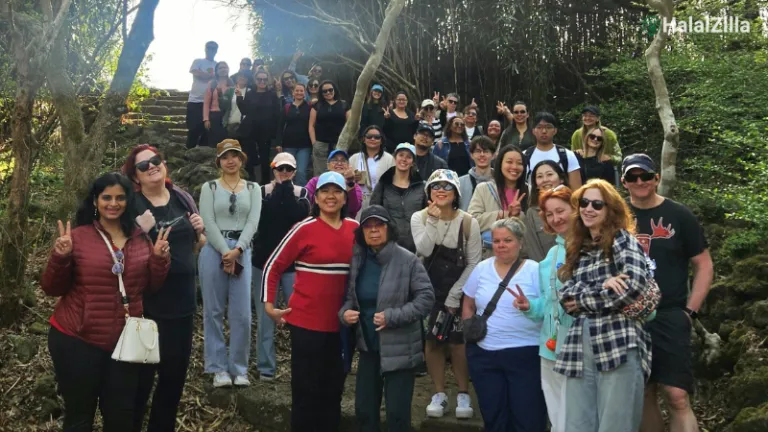 Now, you may be wondering, “That’s my transportation in Jeju‑si covered, but what about beyond the city centre?” I mean, many of the really iconic attractions on Jeju are located outside the city, right? Well, my dear Muslim reader, you’re right in that regard. So, let me introduce you to the not‑so‑elusive concept of day tours!
Now, you may be wondering, “That’s my transportation in Jeju‑si covered, but what about beyond the city centre?” I mean, many of the really iconic attractions on Jeju are located outside the city, right? Well, my dear Muslim reader, you’re right in that regard. So, let me introduce you to the not‑so‑elusive concept of day tours!
Day tours have always had the reputation of being overly touristy and, at times, too expensive. However, let’s look at this from a practical standpoint: beyond Jeju‑si, the only feasible modes of transportation around the island are extremely infrequent buses, or the good ol’ trusty car. This can pose a problem for those who are strapped for time, as navigating around the island may be a tad confusing, especially if, like me, you don’t speak Korean. Plus, the prospect of incurring the cost of a car rental, be it self‑drive or private hire, alongside the mounting cost of fuel, does not seem particularly appealing to the budget‑conscious traveller.
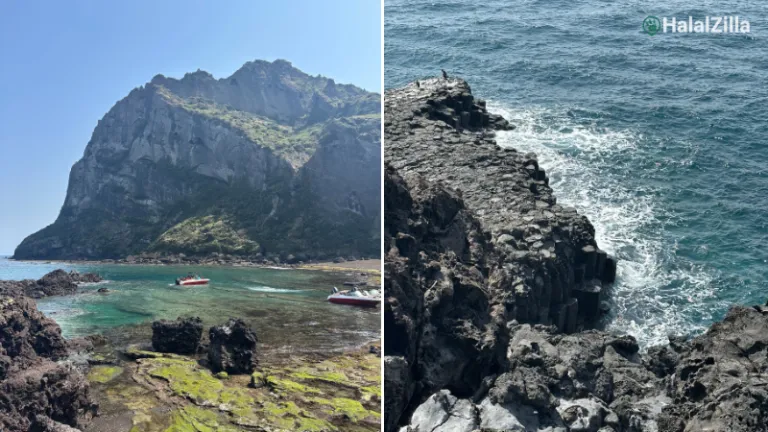 Therefore, the concept of a day tour becomes both handy and attractive, as you’re able to zip around Jeju, pausing at the island’s headline sights, without the fear of getting lost (in translation or literally). Over two days, I joined YEHA Tour and Core Travel, exploring eastern and southern Jeju respectively: Ascending the iconic Seongsan Ilchulbong, marvelling at Daepo Jusangjeolli Cliff’s hexagonal lava formations, and even witnessing a Haenyeo women diver demonstration. Each tour offered hotel pick‑up (yes, directly from Lotte City Hotel Jeju), English‑speaking guides who fielded my many questions, and also the chance to meet other solo travellers from around the globe!
Therefore, the concept of a day tour becomes both handy and attractive, as you’re able to zip around Jeju, pausing at the island’s headline sights, without the fear of getting lost (in translation or literally). Over two days, I joined YEHA Tour and Core Travel, exploring eastern and southern Jeju respectively: Ascending the iconic Seongsan Ilchulbong, marvelling at Daepo Jusangjeolli Cliff’s hexagonal lava formations, and even witnessing a Haenyeo women diver demonstration. Each tour offered hotel pick‑up (yes, directly from Lotte City Hotel Jeju), English‑speaking guides who fielded my many questions, and also the chance to meet other solo travellers from around the globe!
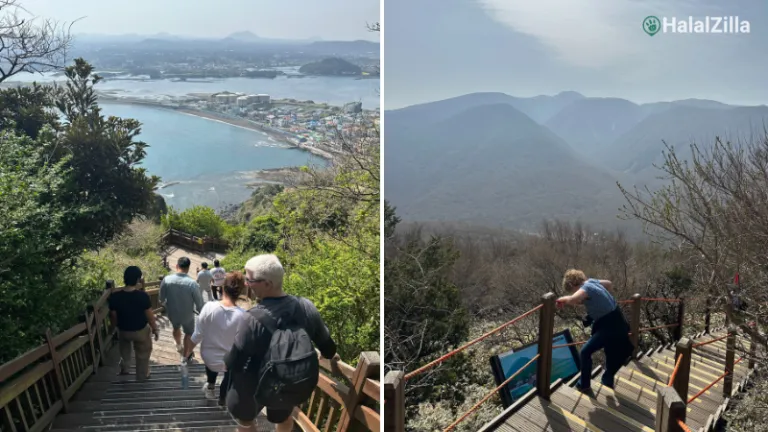 Here’s the cost for each tour:
Here’s the cost for each tour:
YEHA Tour’s East Course: US$80 (S$104.86)
Core Travel’s South Course: US$120 (S$157.29)
You might be wondering, “what’s with the price difference?”. Well, YEHA Tour runs a large coach, which is great for social butterflies, while Core Travel’s small group (I toured with just two Americans) allows one‑on‑one interaction with the guide. So, it really depends on your preferred travel style. Tours generally run 9am to 6pm and are all‑inclusive, covering entry fees and lunch (more on that later).
Total damage: S$262.15 for both tours
5. Sightseeing savings: Free (or nearly free) highlights
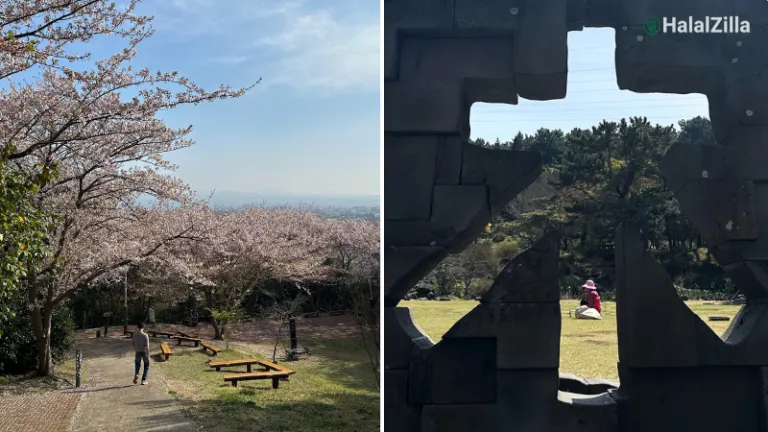 Time for the F‑word: Free! Jeju’s pristine landscapes and vibrant culture are its prime draw, and many highlights cost nothing. Because YEHA Tour and Core Travel include admission to hotspots like Seongsan Ilchulbong and Daepo Jusangjeolli, I didn’t spend an extra won there.
Time for the F‑word: Free! Jeju’s pristine landscapes and vibrant culture are its prime draw, and many highlights cost nothing. Because YEHA Tour and Core Travel include admission to hotspots like Seongsan Ilchulbong and Daepo Jusangjeolli, I didn’t spend an extra won there.
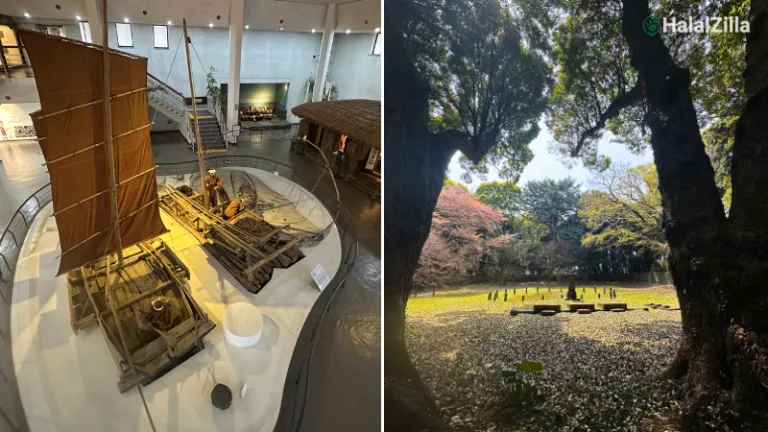 Meanwhile, in Jeju‑si, I marvelled at Yongyeon Suspension Bridge and Yongduam Rock, climbed Dodubong Oreum, and strolled through Halla Arboretum, all for zero Korean won! Some stops on the Jeju City Tour Bus do charge modest fees. I paid ₩2,000 (S$1.85) at the fascinating Jeju Folklore & Natural History Museum and ₩4,000 (S$3.70) at the stunning Samseonghyeol shrine.
Meanwhile, in Jeju‑si, I marvelled at Yongyeon Suspension Bridge and Yongduam Rock, climbed Dodubong Oreum, and strolled through Halla Arboretum, all for zero Korean won! Some stops on the Jeju City Tour Bus do charge modest fees. I paid ₩2,000 (S$1.85) at the fascinating Jeju Folklore & Natural History Museum and ₩4,000 (S$3.70) at the stunning Samseonghyeol shrine.
Total damage: ₩6,000 (S$5.54) – Insane value for five packed days!
6. Halal eats: Savouring Jeju’s flavours
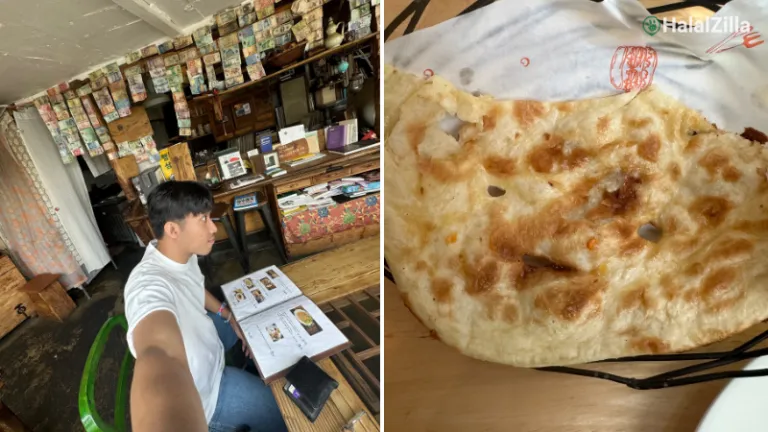 Perhaps the greatest concern for us Muslim travellers in a foreign country where Islam is not the majority religion is the accessibility of Halal food. I’m not going to lie: This was also a major concern for me while researching for this trip. South Korea is generally perceived to be one of those countries where Halal food is hard to come by, and Jeju is no exception.
Perhaps the greatest concern for us Muslim travellers in a foreign country where Islam is not the majority religion is the accessibility of Halal food. I’m not going to lie: This was also a major concern for me while researching for this trip. South Korea is generally perceived to be one of those countries where Halal food is hard to come by, and Jeju is no exception.
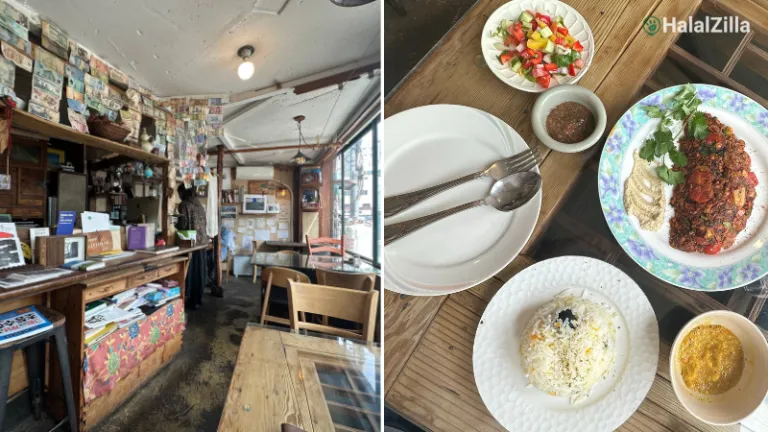 However, I was pleasantly surprised by the variety of Halal food available for Muslim travellers, even within Jeju‑si. One gastronomical highlight of my trip included my lunch at Wardah Restaurant, which served the most sublime Yemeni food among other Middle Eastern delights, set in a small, cosy space with the most charming décor. I had the spicy agdah chicken (which I highly recommend!), served with rice, hummus and a lentil soup, and my bill ended up being ₩20,000 (S$18.48), which is a reasonable price to pay for lunch.
However, I was pleasantly surprised by the variety of Halal food available for Muslim travellers, even within Jeju‑si. One gastronomical highlight of my trip included my lunch at Wardah Restaurant, which served the most sublime Yemeni food among other Middle Eastern delights, set in a small, cosy space with the most charming décor. I had the spicy agdah chicken (which I highly recommend!), served with rice, hummus and a lentil soup, and my bill ended up being ₩20,000 (S$18.48), which is a reasonable price to pay for lunch.
 Another highlight was the famous seafood joint, Halal Bada Janchi Restaurant, just a stone’s throw away from the Yongyeon Suspension Bridge, so you can definitely head there for a post‑meal stroll to help digest all that tasty seafood! I had the grilled shrimp, which came to ₩12,000 (S$11.09), accompanied by rice at ₩1,000 (S$0.92) and steamed eggs at ₩3,000 (S$2.77), bringing my total to ₩16,000 (S$14.79). So yummy and affordable!
Another highlight was the famous seafood joint, Halal Bada Janchi Restaurant, just a stone’s throw away from the Yongyeon Suspension Bridge, so you can definitely head there for a post‑meal stroll to help digest all that tasty seafood! I had the grilled shrimp, which came to ₩12,000 (S$11.09), accompanied by rice at ₩1,000 (S$0.92) and steamed eggs at ₩3,000 (S$2.77), bringing my total to ₩16,000 (S$14.79). So yummy and affordable!
Muslim‑Friendly Restaurants in Jeju‑si
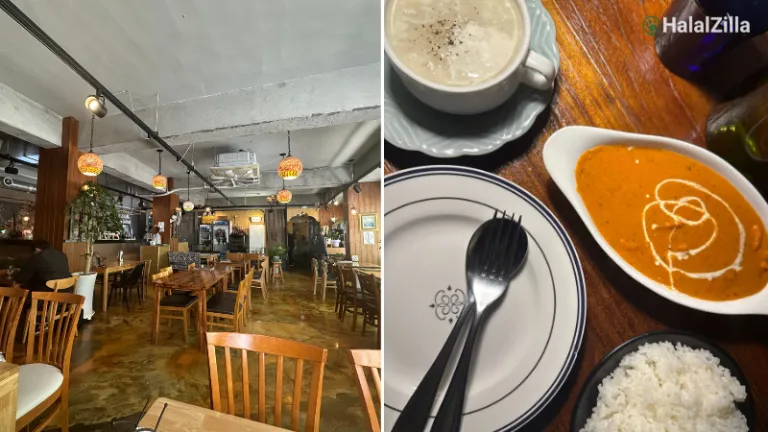 Here are some other Muslim-friendly restaurants I dined at during my trip:
Here are some other Muslim-friendly restaurants I dined at during my trip:
Rajmahal Indian Restaurant: Expect tasty North Indian cuisine, such as naan and butter chicken, at this cosy restaurant located in Shin Jeju, just a 10‑minute walk from my hotel. Expect to spend ₩20,000 (S$18.48) onwards.
Bagdad Café: Another Indian (and a little Middle Eastern as well!) joint, just a five‑minute walk from the iconic Dongmun Market. While you won’t find many Halal‑friendly options at the market outside the vegetarian and vegan fare, you won’t have to worry about starving yourself after your market adventures with this restaurant sitting close by! Expect to spend ₩10,000 (S$9.24) to ₩20,000 (S$18.48) here.
Halal Daewonga Seafood Restaurant: This Muslim‑friendly seafood restaurant in Gu Jeju is known for its fresh abalone stew, as well as cutlassfish, a speciality of Jeju Island. Don’t miss it while you’re there! Expect to spend ₩20,000 (S$18.48) onwards.
Tour Lunches Made Easy
You might be wondering, “But what about the tours I mentioned earlier? Don’t they last the whole day? What about lunch? Are they Muslim‑friendly?” Now, hold your horses: I’m getting to it!
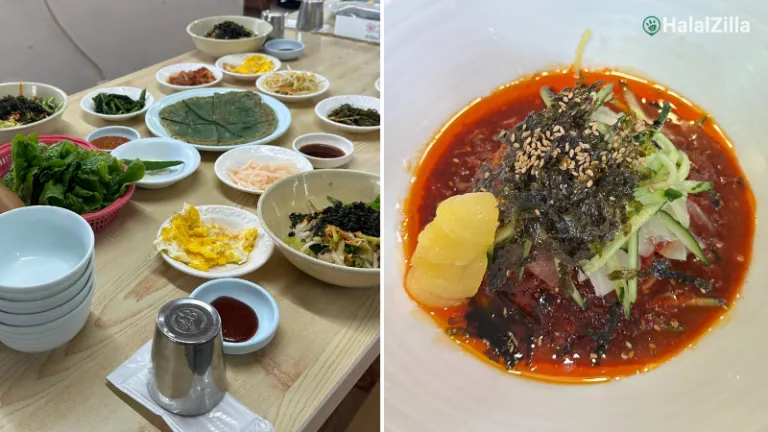 Remember when I mentioned that the YEHA Tour and Core Travel packages were all‑inclusive? Yep, that includes lunch as well!. On both days, I was the only Muslim traveller on board, yet the guides spared no expense in making sure I felt included and catered to my every need. For both lunches, I was offered vegetarian options, including a bibimbap meal complete with banchan side dishes with YEHA Tour, and a traditional cold‑noodle dish flavoured with Jeju’s famous Hallabong tangerines with Core Travel.
Remember when I mentioned that the YEHA Tour and Core Travel packages were all‑inclusive? Yep, that includes lunch as well!. On both days, I was the only Muslim traveller on board, yet the guides spared no expense in making sure I felt included and catered to my every need. For both lunches, I was offered vegetarian options, including a bibimbap meal complete with banchan side dishes with YEHA Tour, and a traditional cold‑noodle dish flavoured with Jeju’s famous Hallabong tangerines with Core Travel.
Above all, these meals ensured that I was sustained and energised throughout the long day tours, and not to mention, they were incredibly tasty and Muslim‑friendly too!
Decoding Korea’s Halal Labels
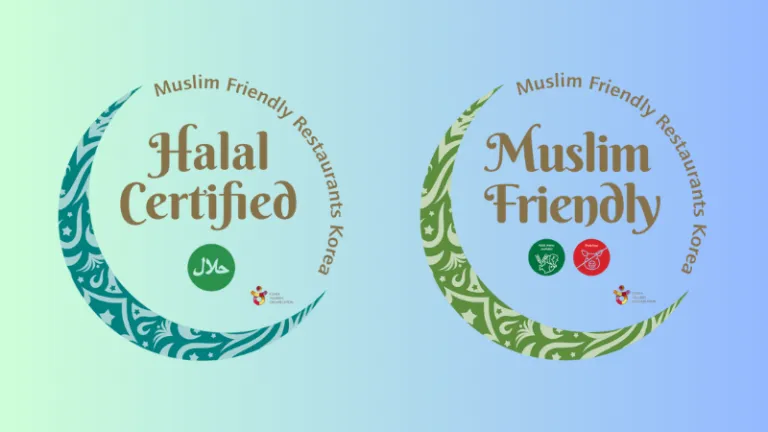 While we’re on the topic of Halal food in Jeju, here’s an interesting tidbit for you Muslim readers! When in South Korea and unsure whether an eatery is genuinely Halal, look for official signs sanctioned by the Korean Tourism Organization.
While we’re on the topic of Halal food in Jeju, here’s an interesting tidbit for you Muslim readers! When in South Korea and unsure whether an eatery is genuinely Halal, look for official signs sanctioned by the Korean Tourism Organization.
“Halal‑Certified” means the restaurant has passed a certification test by a recognised agency, employs at least one Muslim operator and cook, and offers an entirely Halal menu. Meanwhile, “Muslim‑Friendly” indicates that some or all menu items are Halal (with non‑Halal meats stored and prepared separately and alcohol possibly served), and the Halal choices will be clearly marked, so not to worry!
Total damage: S$150
Myth Busted: Jeju on a Budget Is Real
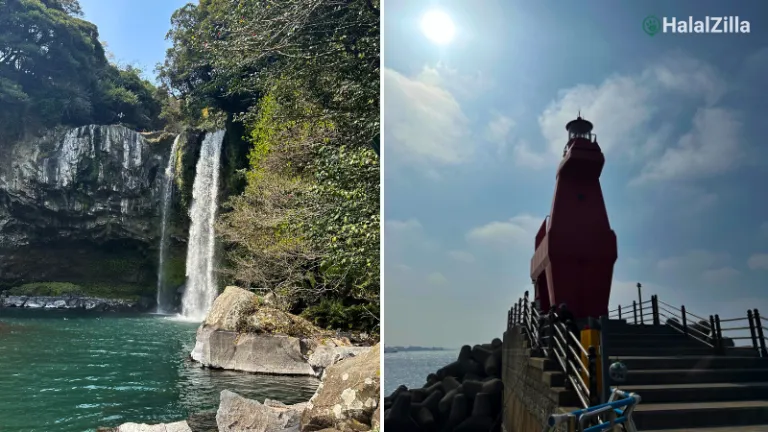 And there you have it: My five‑day, four‑night Jeju adventure cost S$1,717.03 in total! This excludes small extras like souvenirs or convenience‑store snacks, which shouldn’t set you back much (unless you’re buying presents for all your 50 distant relatives back home, haha!). Of course, you could trim costs further: Swap a hotel for a hostel, travel off‑season, or book flights with stopovers instead of a direct peak‑season route.
And there you have it: My five‑day, four‑night Jeju adventure cost S$1,717.03 in total! This excludes small extras like souvenirs or convenience‑store snacks, which shouldn’t set you back much (unless you’re buying presents for all your 50 distant relatives back home, haha!). Of course, you could trim costs further: Swap a hotel for a hostel, travel off‑season, or book flights with stopovers instead of a direct peak‑season route.
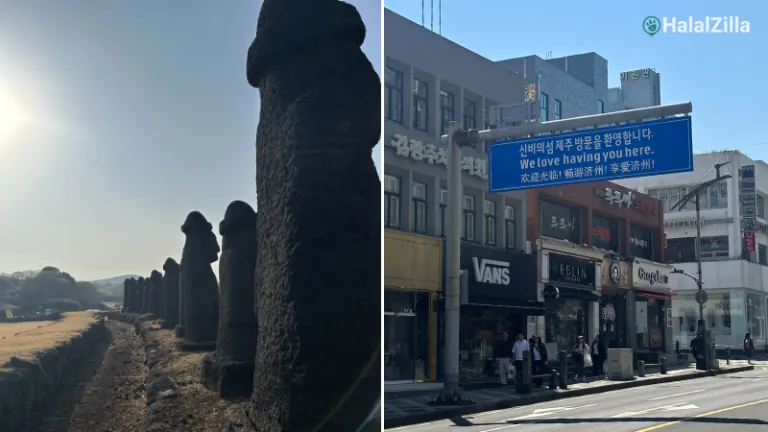 However, the point of this article is to debunk the myth that you need to spend a fortune for a comfortable, Halal‑friendly Jeju holiday. Compared with Seoul or Busan, Jeju is hardly extortionate! Its UNESCO‑listed volcanic landscapes, unique traditions and surprisingly diverse Halal dining scene make it a destination like no other, and thanks to day tours, city‑tour buses and savvy planning, it welcomes Muslim travellers without emptying their wallets.
However, the point of this article is to debunk the myth that you need to spend a fortune for a comfortable, Halal‑friendly Jeju holiday. Compared with Seoul or Busan, Jeju is hardly extortionate! Its UNESCO‑listed volcanic landscapes, unique traditions and surprisingly diverse Halal dining scene make it a destination like no other, and thanks to day tours, city‑tour buses and savvy planning, it welcomes Muslim travellers without emptying their wallets.
So, what are you waiting for? Jeju is beckoning – Will you answer its call?
_____________________________________________________________________________________________
Special thanks to Jeju Tourism Organization for inviting me on such a memorable trip in Jeju!
Published at
About Author
Khaizuran Rashid
Subscribe our Newsletter
Get our weekly tips and travel news!
Recommended Articles
10 Best Halal-Friendly Destinations in The Philippines for Muslim Travellers 10 Best Halal Restaurants in Pattaya Serving Authentic Thai Cuisine Let's try Halal Authentic Thai Cuisine in Pattaya
10 Best Places for Muslim Travellers to See Tulip Festivals in 2025 Fun Fact: Tulips didn’t actually come from the Netherlands but Türkiye!
10 Halal Anime Food Guide for Muslim Travellers in Japan Muslim-friendly versions of popular anime dishes across Japan!
Top 10 Popular Muslim-Friendly Destinations to Visit in 2025 Our schedules are packed, buddies!
Latest Articles
Beast Land Riyadh 2025: MrBeast’s Theme Park Opens With Rides, Challenges & Muslim-Friendly Tips Experience the exclusive MrBeast’s theme park from 13 Nov to 27 Dec 2025!
11 Must-See Winter Illuminations in Osaka 2025–2026 for Muslim Travellers Experience winter in Osaka with lights, snow & festive fun
What Travellers Need to Know About Indonesia's Mount Semeru Eruption Mount Semeru’s status raised to alert level
What I Learned About Hong Kong While Travelling as a Muslim Oh come on, HK isn't just about Disneyland!
New Grab Sampan in Malaysia: A Muslim-Friendly Way to Explore the Sarawak River Grab Sampan can be booked online via cashless payments!

